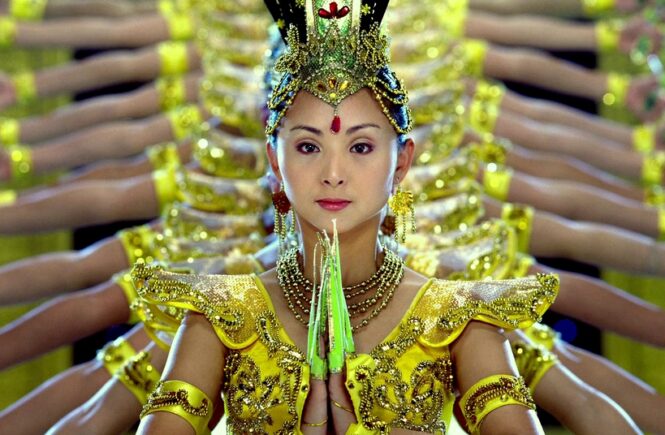
Originally published in June, 2016.
“If we lived forever, if the dews of Adashino never vanished, if the crematory smoke on Toribeyama never faded, men would hardly feel the pity of things. The beauty of life is in its impermanence… Yet for such as love the world, a thousand years would fade like the dream of one night.”
– Kenko Yoshida, “Essays In Idleness”
Seeing “Samsara” is like stopping the Earth and watching, with a thousand eyes, the human life upon it. I’ve always found it hard to grasp the vastness of the Earth, teeming and crumbling with all its exotic places and cultures. By no means does “Samsara” show all of Earth’s beauty, rather it stunningly evokes the feeling of finding that such beauty exists.
There is one particular shot in this film that captured my curiosity, it is of a woman positioned in the center of the screen with a wave of hands behind her, an eye in the palm of each hand. It’s one of the dances you see in the film, called the thousand-hand Guan Yin. It’s a story of compassion. The woman at the center of the screen, Guan Yin, is an advanced spiritual being who has the potential to reach Nirvana but delays it in order to help those in need on Earth.
The first time we see a shot of Guan Yin is near the beginning of the film, she is shown closing her eyes. The last scene of the film is of her opening her eyes, doing the dance of the thousand-hand Guan Yin, and then closing her eyes once again. In-between these two shots the film happens, and I always thought of everything we see in the film as occupying the moment between the closing and opening of her eyes. To me it is a humbling experience. The portraits of religion, industry, culture, and violence all taking place on Earth at the same time, between the opening and closing of eyelids.
Filmed in 25 countries, over 5 years, “Samsara” is film in the purest form. It uses no words, it speaks through images. It rarely draws conclusion and it also does not tell you anything about the various cultures or people in the film. If you want, you can go to the IMDB webpage of this film and look at the credited cast listing to seek out your curiosity.
Maybe in the future Ron Fricke will make a similar film, not only focusing on Earth, but widening the image into the solar system. Maybe he can film life on Mars, Europa, or Titan. Why stop there? A film in this style can also chronicle life in the Milky Way Galaxy; the worlds perishing, perished, and created. Even more ambitious would be a film of life in all the known universe, ranging across the light years. I wonder. “Samsara” is a type of film that need not be bounded to Earth.
In truth, I find it hard to pinpoint what this film is about, it won’t be the same for everyone. But to me “Samsara” was an exercise in humility, a coming to terms with the impermanence of the world around us. It’s rare to find a film that goes through the breath of life in such a way as to convey the fragility of existing itself.
Near the beginning of the film, we see some Tibetan monks intricately making a pattern out of colored sand on the floor. Days must have been put into it, meticulously grinding out pieces of colored sand into structures, clouds, and people. Then after the design is done, the monks all stand around their work. They admire it, and then one of the monks cuts the pattern with 4 lines, as the rest of the monks then proceed to brush it out. They collect the now mixed color of sand into a bowl, soon to be dispersed into water. I wonder what pattern will be drawn next.
Samara- (Sanskrit for) Cyclic Existence




